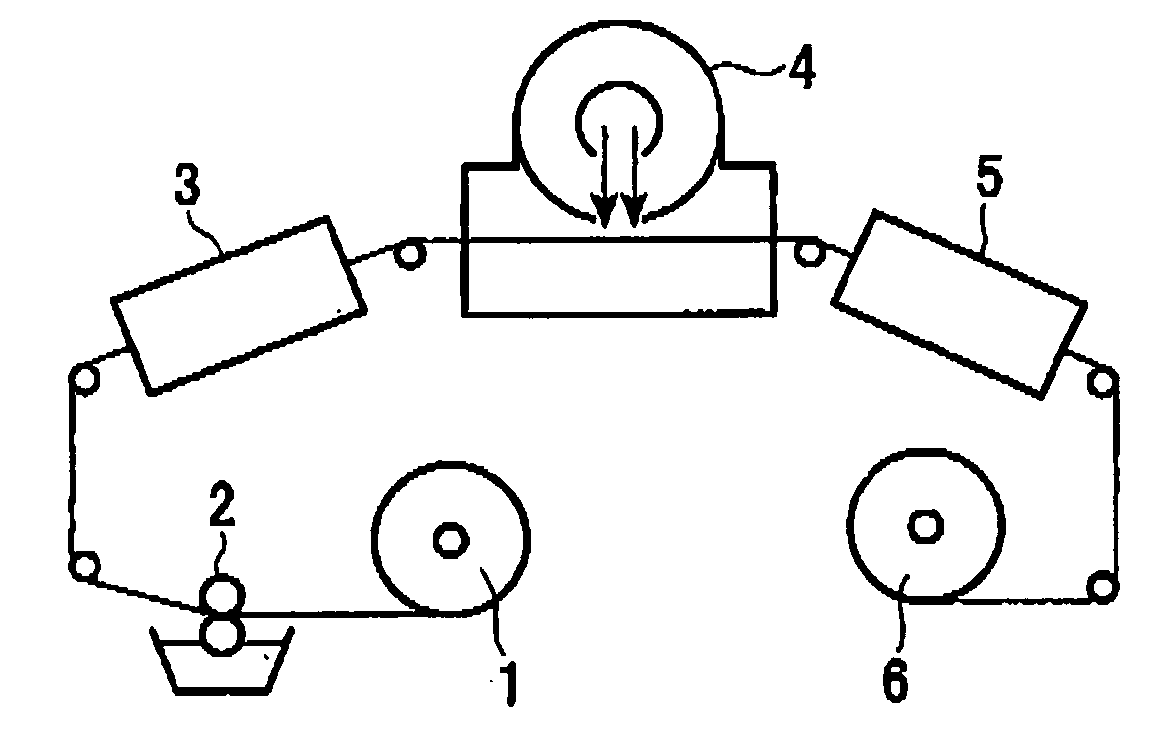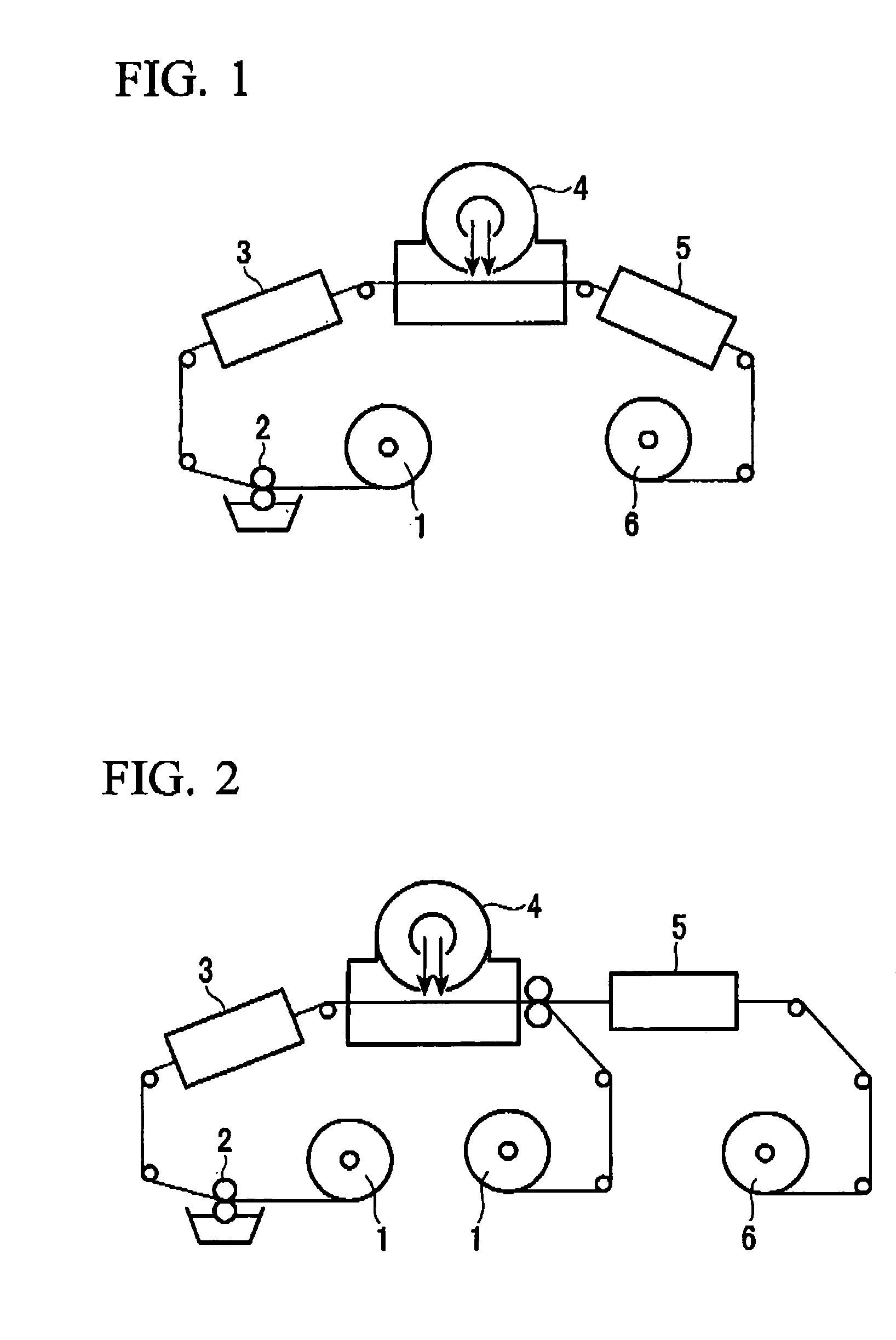Foam sheet and production process thereof
a technology of foam sheet and production process, which is applied in the field of foam sheet, can solve the problems of insufficient durability and crack resistance, inability to produce thin foam sheets using conventional forming processes, and formation of internal defects in the material itself, and achieves the effects of high reflection efficiency, convenient production, and satisfactory workability
- Summary
- Abstract
- Description
- Claims
- Application Information
AI Technical Summary
Benefits of technology
Problems solved by technology
Method used
Image
Examples
example 1
(1) Preparation of a Coating Liquid of a Foamable Composition
[0318]A foam sheet was produced in the following manner. 3 parts of an iodonium salt-based acid generator in the form of bis(4-tert-butylphenyl) iodonium perfluorobutane sulfonate (trade name: BBI-109, manufactured by Midori Kagaku) were mixed with 100 parts of a copolymer of tert-butylacrylate / methyl methacrylate (weight ratio: 60 / 40) used as a decomposing compound, followed by dissolving in ethyl acetate to prepare a solution having a solid content of 25% which was used as a coating liquid. This coating liquid was coated onto one side of a support composed of transparent polyethylene terephthalate (trade name: Lumirror 75-T60, manufactured by Panac) having a thickness of 75 μm using an applicator bar having a gap width of 150 μm. Subsequently, the solvent was removed by evaporation by allowing to stand for 1 minute in a constant temperature dryer at 100° C. A thin film-like, colorless and transparent coated layer was for...
example 2
[0327]A foam sheet in the form of a thin film having microcells was produced in the same manner as Example 1. However, it was heated for 2 minutes at 120° C. in a hot air oven in step (3) of Example 1.
[0328]The results of determining foam thickness, cell diameter and foam expansion ratio in the same manner as Example 1 are shown in Table 3. A thin foaming film having high foam expansion ratio was able to be obtained that was difficult to realize in the prior art.
TABLE 3Foam Structure of Foam Film of Example 2Foam thicknessCell diameterFoam expansion(μm)(μm)ratio6029.1
[0329]The thermal conductivity λ of the film before and after foaming was determined using the equation below from the measured values of thermal diffusivity α, density ρ and specific heat Cp.
λ=α·ρ·Cp
[0330]Thermal diffusivity α was measured using a thermal diffusivity measuring apparatus based on the alternating current heating method (cf. International Journal of Thermophysics, Vol. 18, No. 2, p. 505-513 (1997)). Spec...
example 3
[0332]A foam sheet in the form of a thin film having microcells was produced in the same manner as Example 1. However, a copolymer of tert-butyl acrylate (20% by weight), tert-butyl methacrylate (37% by weight) and methyl methacrylate (43% by mass) was used instead of the poly(tert-butyl acrylate / methyl methacrylate (60 / 40)) used for the decomposing compound in step (1) of Example 1. In addition, ultraviolet light was used instead of the electron beam used for the active energy beam in step (2) of Example 1. This ultraviolet light was irradiated using an ultraviolet irradiation apparatus (manufactured by USHIO INC.) equipped with a Y-ray lamp (of which peak wavelength is 214 nm) at an irradiated dose of 3000 mJ / cm2, followed by heating for 2 minutes at 120° C. in a hot air oven in step (3) of Example 1. At this time, the coated layer changed from a colorless, transparent layer to a white layer in the same manner as Example 1, and a foam sheet was able to be formed having a foam thic...
PUM
| Property | Measurement | Unit |
|---|---|---|
| mean cell diameter | aaaaa | aaaaa |
| thickness | aaaaa | aaaaa |
| porosity | aaaaa | aaaaa |
Abstract
Description
Claims
Application Information
 Login to View More
Login to View More - R&D
- Intellectual Property
- Life Sciences
- Materials
- Tech Scout
- Unparalleled Data Quality
- Higher Quality Content
- 60% Fewer Hallucinations
Browse by: Latest US Patents, China's latest patents, Technical Efficacy Thesaurus, Application Domain, Technology Topic, Popular Technical Reports.
© 2025 PatSnap. All rights reserved.Legal|Privacy policy|Modern Slavery Act Transparency Statement|Sitemap|About US| Contact US: help@patsnap.com



